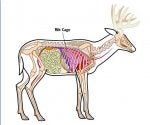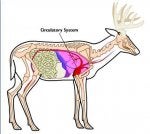An article taken from a Game & Fish Commission site ( Idaho):
Choosing the Proper Shot Angle
The shot angle is the angle at which the animal is standing in relation to the hunter. Knowing which angles offer the most effective—and least effective—shots is an essential part of being a responsible hunter.
Broadside
The broadside shot angle is the preferred shot angle for both firearm and bow hunters for larger game animals, such as elk, deer, and bear.
- Firearm: The broadside position offers several excellent shots for a firearm hunter. The best target is the shoulder and chest area. A bullet of the correct weight and fired from a firearm adequate for the game will break the shoulder bone and enter the lungs or heart.
- Bow: The broadside angle offers the best shot for the largest big game animals, such as elk, deer, and bear. For most big game, the aiming spot is straight up from the back side of the front leg, one-third of the way up from the bottom of the chest. An arrow will penetrate the ribs but not the shoulder bone; wait until the near leg is forward, and aim behind the shoulder.
The most effective firearm shot for a turkey is to the head and neck. The preferred shot angle for bowhunters is broadside, aiming for the heart or lungs.
The preferred shot for larger game animals, such as elk, deer, and bear, is broadside.
Quartering-Away
The quartering-away shot angle is when your target is facing away from you, but at an angle. The animal is usually looking away from you.
- Firearm: For firearm hunters, the quartering-away position offers several aiming spots on all big game. The area just behind the shoulder is the best aiming spot for direct penetration of the vital organs. Focus on hitting the chest area above the opposite front leg.
- Bow: The quartering-away shot angle offers a good opportunity for a clean kill on antelope, white-tailed deer, mule deer, black bear, and other big game of similar size or smaller. *This is not a good shot for bowhunters on larger game because their massive stomachs and intestines will block a clean shot to the lungs or heart. The opposite front leg is a good reference point for aiming.
*(
Notice they don't recommend shooting through the stomach since this will contaminate the meat. You're not likely to hit both
lungs unless you pass through the gut area. However this is a deadly shot for archery. In reality, you're just contaminating one
front shoulder which is not all that much meat & from a tree stand you likely would not hit the shoulder, since the path of the
arrow would be into the lower part of the leg.)
Quartering-Toward
The quartering-toward shot angle is when the animal is facing toward you, but at an angle. Since the animal is typically looking your way, it most likely will spot your movements.
- Firearm: The quartering-toward angle presents a clean shot to the vital organs. A shot can be taken at this angle if the gun is already trained on the animal. For an effective hit, aim at the front of the shoulder of the near front leg. Caution: A light bullet may deflect off the shoulder bones of large game, such as elk, deer, or large bears. Be certain to use a firearm and ammunition adequate for the game you hunt and the angle of shot you might select.
- Bow: This angle offers a poor shot opportunity and should not be taken. Heavy shoulder bones shield the majority of vital organs from broadhead-tipped arrow penetration. Also, bowhunters should never fire an arrow at an animal that is looking at them.
Head-On
The animal will certainly detect your movements with a head-on shot angle.
- Firearm: A head-on shot can be effective if you have an adequate firearm and your firearm is already positioned for the shot. However, head-on shots rarely result in a clean kill and ruin a lot of meat. Aim at the center of the chest to hit the vital organs.
- Bow: These angles offer very poor shot selection and should not be taken. Heavy bones in front and muscle mass and non-vital organs in back block penetration of the main vital areas.
Rear-End
The rear-end shot
should not be taken by hunters using firearms or bows.



